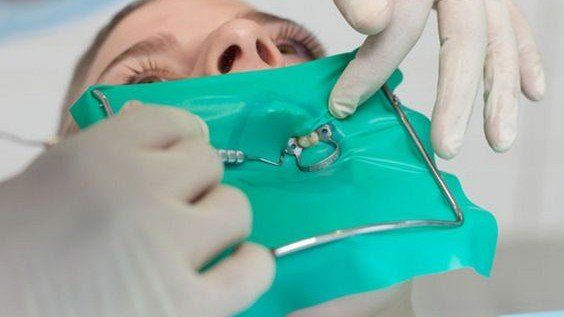RUBBER DAM
Our patients’ safety is our utmost priority.
At Smile Design Dental Practice, we frequently utilise rubber dams during dental procedures, including root canal treatments and dental restorations.

How is the Rubber Dam being placed?
The rubber dam is placed over a patient’s mouth, with a small clamp attached to the tooth alongside the edge of the gums, exposing only the tooth being worked on.
One or more holes may be created to allow our dentist to work on multiple teeth simultaneously. For instance, we can work on various dental fillings by isolating a few teeth at a time. This rubber dam is stretched and held in position with a U-shaped metal or plastic frame.
Rubber Dam for Your Safety and Better Outcomes
The rubber dam, also known as a dental dam, was first seen in the United States in 1864. It is a very thin square sheet usually made of nitrile or latex. The primary reason for producing two different materials is to cater to patients with a latex allergy.
- Isolation and Enhance Patient’s Safety
A rubber dam’s main purpose is to act as a physical barrier by isolating the operative area that the dentist is working on from the rest of the patient’s mouth. This helps protect the tongue, throat, and airway during dental procedures and prevents patients from ingesting foreign substances.
For cases where a root canal treatment is conducted, it is crucial to ensure the tooth is isolated so that when the dentist is cleaning the root canals, there is no possibility of saliva or debris re-entering the canals. The dentist is able to clean and seal the canal in a clean environment. - Improve Visibility
When the operative tooth or area is isolated, saliva or moisture is absent, which significantly improves visibility, allowing for better access to the tooth and the placement of curing and restorative materials. - Promotes Infection Control and Prevention of Cross-Contamination
The rubber dam also creates a clean and dry operating area. Our patient’s lips, cheeks, and tongue are being retracted and protected, allowing for treatment of the tooth without contamination from blood or saliva. It helps control the spread of bacteria to neighbouring teeth and reduces the risk of infection. - Increase the Success Rate of Dental Restorations
It is common for dentists to use bonding agents and restorative materials for dental restorations. A rubber dam in place provides a dry and isolated environment, which is crucial for the adhesion of bonding agents and the longevity of dental restorations.
Schedule an appointment with us NOW! Call us at 6463 8588 or WhatsApp to 9815 5336
To serve you better, we are available by Appointment Only.
Please contact us to schedule an appointment.